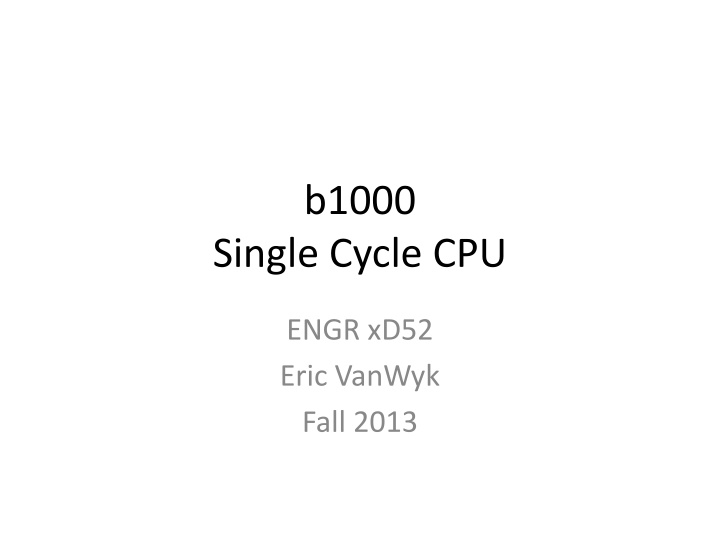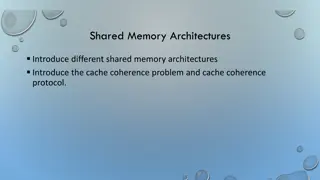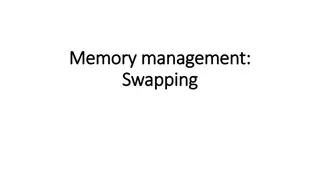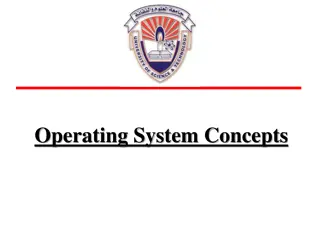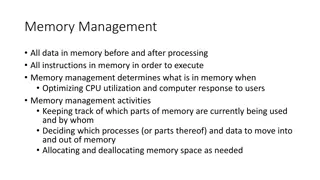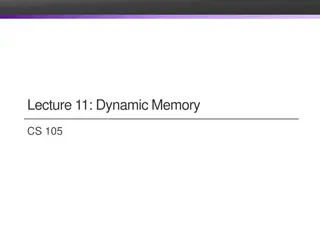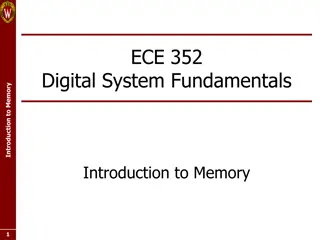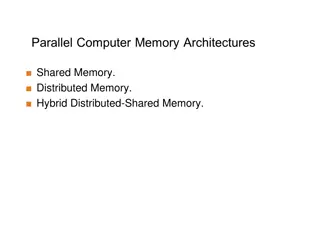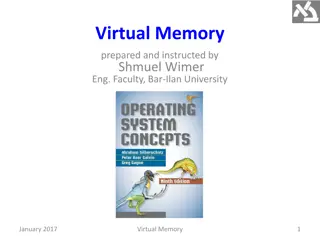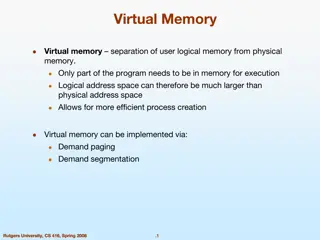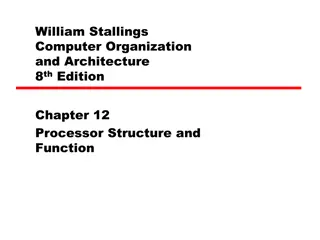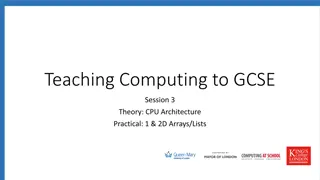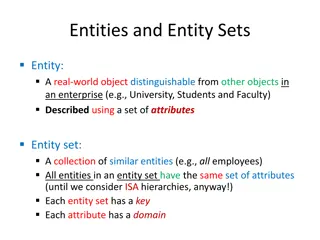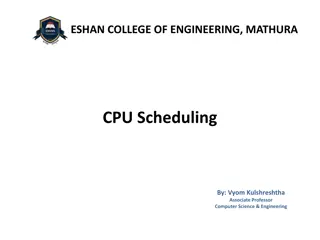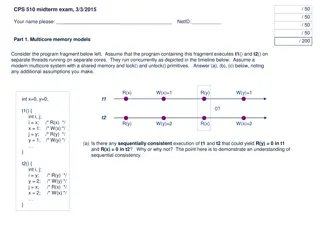Introduction to CPU Design and Memory Attributes
In this material, you will explore the basics of CPU design, focusing on the execution of instructions and memory attributes such as mutability, access types, and volatility. Discover the history of computer memory and dive into different memory types like core memory. Get ready to delve into the world of computer memory interfaces and the building blocks of a computer.
Uploaded on Mar 04, 2025 | 0 Views
Download Presentation

Please find below an Image/Link to download the presentation.
The content on the website is provided AS IS for your information and personal use only. It may not be sold, licensed, or shared on other websites without obtaining consent from the author.If you encounter any issues during the download, it is possible that the publisher has removed the file from their server.
You are allowed to download the files provided on this website for personal or commercial use, subject to the condition that they are used lawfully. All files are the property of their respective owners.
The content on the website is provided AS IS for your information and personal use only. It may not be sold, licensed, or shared on other websites without obtaining consent from the author.
E N D
Presentation Transcript
b1000 Single Cycle CPU ENGR xD52 Eric VanWyk Fall 2013
Today Intro to Memory The Execution of an Instruction Intro to Simple CPU Design Assign Homework & Lab
Memory Look Up Table is a very simple memory Read One thing at a time Write nothing ever Generically, a memory is defined by: Width & Depth Number and Type of Ports How many simultaneous read / write operations Speed (access time)
Memory Attributes Mutability: Read/Write Read Only Write Once Reprogrammable Access Type Random Sequential Volatility: Non-Volatile Volatile Refreshed
Historical Side Note History of Computer Memory is Amazing Consider it for your final project Crazy Memory Types: Delay Line Sound waves through quartz/mercury Lasers reflected off the moom Williams Tube Cathode Ray Tube + Static Electricity
Historical Memory: Core http://en.wikipedia.org/wiki/Magnetic-core_memory
Memories We will devote several lectures entirely to memory I will treat it as an opaque black box for this lecture, and open it in much more detail later Your next lab is about memory interfaces
Context We now have almost all of the building blocks of a computer! Nearing completion of our first spiral Today we will glance at the important ones Moving forward we will dive deeper into each of these building blocks to expand capabilities
Context You will learn the dark arts of box opacity Practice thinking hierarchically So what does a CPU do?
CPU Execution Overview Fetch instruction from memory Decode instruction into actions/controls Fetch/Decode operands Compute result value or status Push result(s) to storage Determine next instruction Instruction Fetch Instruction Decode Operand Fetch Execute Result Store Next Instruction
What boxes do we need? Memory for Instructions Something to unpack instructions Memory for data Something to compute stuff Instruction Fetch Instruction Decode Operand Fetch Execute Result Store Next Instruction
What boxes do we need? Memory for Instructions Something to unpack instructions Memory for data Something to compute stuff Instruction Fetch Instruction Decode Operand Fetch Execute Result Store Next Instruction
Processor Overview Overall Dataflow PC fetches instructions Instructions select operand registers, ALU immediate values ALU computes values Load/Store addresses computed in ALU Result goes to register file or Data memory
Program/Instruction Memory Large, single ported read-only memory For today Stores the program the processor executes Instructions are 4 bytes wide For today
Register File Very small, very fast multi-ported memory Small depth, large silicon area Each cycle reads 2 words, optionally writes 1 This is the scratch space for the processor Aw Aa Ab Da Dw Db Register WrEn File This is homework soon
Assembly The human readable version of the instructions the machine executes Closely related to Op Codes and Instructions We will go over this in detail soon.
Instruction Decode Today we are black boxing instructions Blue Wires come from the Instruction Decoder Control signals that tell the CPU what to do E.g. ALU Control Lines Addresses
Instruction RTL RTL is Register Transfer Level Short Hand for what the instruction should do Reg[Rd] = Reg[Rs] & Reg[Rt] Set the memory at location Rd equal to the data at location Rs boolean anded with the data at location Rt.
Fetch Operands Get Operand Addresses Pull from Register File Reg[Rd] = Reg[Rs] & Reg[Rt] Rd RsRt Reg[Rs] Reg[Rt] Aw AaAbDa Dw Db Register WrEn File
Execute ALU controls from Instruction Fetch/Decode Perform actual computation in ALU Reg[Rd] = Reg[Rs] & Reg[Rt] ALUcntrl Rd Rs Rt Aw Aa Ab Da Dw Db Register WrEn File Reg[Rs]&Reg[Rt]
Store Results Store the result back to the register file Others Instructions have other effects Reg[Rd] = Reg[Rs] & Reg[Rt] ALUcntrl Rd Rs Rt Aw Aa Ab Da Dw Db Register WrEnFile RegWr
Using Constants Sometimes we want to use a constant as an operand instead of a Register. How do you encode a 32 bit constant AND control signals into a 32 bit instruction? Side Note: The Cortex has interesting options any constant produced by shifting an 8-bit value any constant of the form 0x00XY00XY any constant of the form 0xXY00XY00 any constant of the form 0xXYXYXYXY Side Note: MIPS only has boring 16 bit constants
Using Constants (Immediates) Reg[rt]= Reg[rs]+SignExtend(imm); How do we choose ALU Source? Rt Rs ALUcntrl Aw Aa Ab Da Dw Db Register WrEn File RegWr SignExtnd Imm16
Data Memory WrEn Addr Din Dout Data Memory Big Giant Slow Memory Gigabytes! Read and Write, but only single port Write Enable (WrEn) switches between the two modes Pulling from Data Memory to Register Load Push from Register to Data Memory Store
Hook Up On The Boards Create simple CPU with 4 types of instructions Listed on next Slide Use the following Components ALU, Register File, Data Memory, Sign Extender Use another marker color for control signals To make a decision, use a MUX
Quick Note on rd, rs, rt Aw is inconsistent in the MIPS standard Sometimes rt Sometimes rd This is ok! Makes other things clearer later I don t always have to choose between two signals, but when I do, I choose Multiplexor
Hook Up On The Boards Math with 2 Variables Reg[rd] = Reg[rs] op Reg[rt]; Math with 1 variable and 1 constant Reg[rt] = Reg[rs] op SignExtend(imm); Load from data memory Addr = Reg[rs] + SignExtend(imm); Reg[rt] = Mem[Addr]; Store to data memory Addr = Reg[rs] + SignExtend(imm); Mem[Addr] = Reg[rt];
One Possible Complete Datapath Rd Rt RegDst Rs Rt ALUcntrl MemToReg MemWr Aw Aa Ab Da Dw Db Register WrEn File WrEn Addr Din Dout Data Memory RegWr SignExtnd imm16 ALUSrc
With the remaining time Work on Lab
Using Constants (Immediates) Instruction Fetch Unit Rd Rt Rs Rt Rd Imm16 RegDst Rs Rt ALUcntrl Aw Aa Ab Da Dw Db Register WrEn File RegWr WrEn Addr Din Dout Data Memory SignExtnd imm16 ALUSrc
Datapath + Load Addr = Reg[rs] + SignExtend(imm); Reg[rt] = Mem[Addr]; Instruction Fetch Unit Rd Rt Rs Rt Rd Imm16 RegDst Rs Rt ALUcntrl MemWr Aw Aa Ab Da Dw Db Register WrEn File WrEn Addr Din Dout Data Memory RegWr SignExtnd imm16 ALUSrc
Datapath + Store Addr = Reg[rs] + SignExtend(imm); Mem[Addr] = Reg[rt]; Note: State of RegWr, MemToReg? Instruction Fetch Unit Rd Rt Rs Rt Rd Imm16 RegDst Rs Rt ALUcntrl MemToReg MemWr Aw Aa Ab Da Dw Db Register WrEn File WrEn Addr Din Dout Data Memory RegWr SignExtnd imm16 ALUSrc 32
